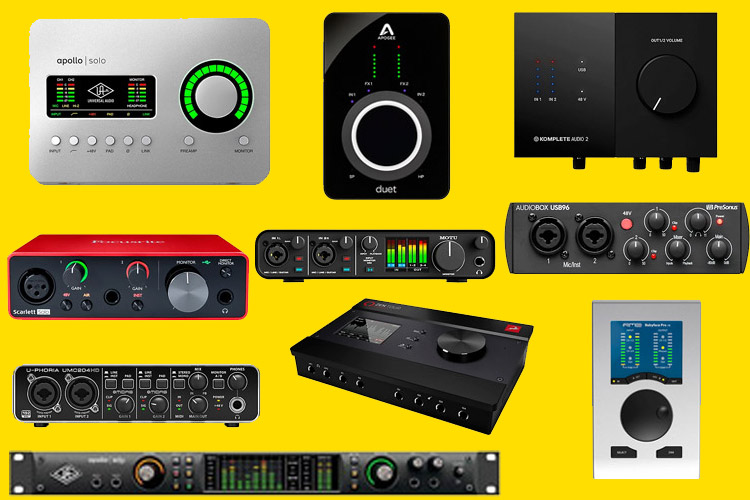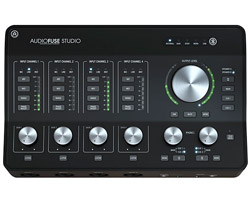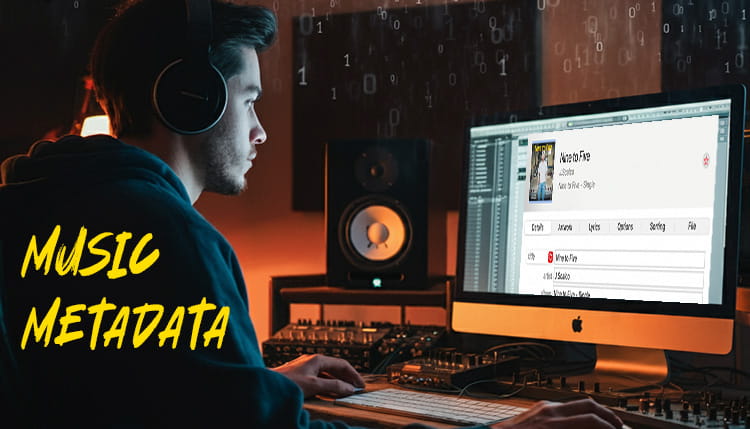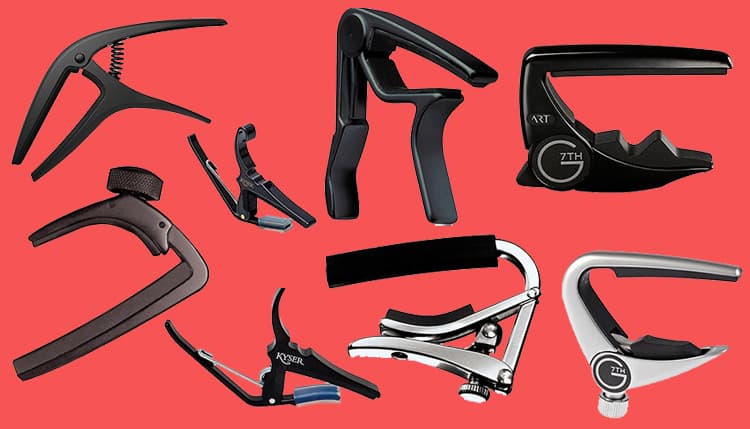Are you ready to take your audio game to the next level?
Whether you’re a budding musician or seasoned producer, finding the best audio interface can make or break your sound quality.
Sound quality is crucial for their enjoyment of audio content.
That’s why we’ve put together this comprehensive guide to the top audio interfaces of 2024.
Get ready to transform your recordings from amateur to pro!
What is an Audio Interface and Why Do You Need One?
Let me tell you, when I first put together my home studio, I was clueless about audio interfaces.
I thought my laptop’s built-in mic would do the trick. Boy, was I wrong!
An audio interface is basically the middleman between your instruments or mics and your computer.
It’s like a translator that converts analog signals to digital ones that your computer can understand.
I remember the first time I plugged in a proper audio interface. It was like cleaning my ears out after years of buildup.
The sound quality was night and day compared to my computer’s crappy built-in audio.
No more buzzing or interference, and the clarity was insane!
Here’s the deal: an audio interface gives you way better sound quality than your computer’s built-in audio.
It’s got preamps to boost weak signals, and analog-to-digital converters that capture sound with way more detail.
Plus, you get proper inputs for mics and instruments, which is a game-changer if you’re recording anything seriously.
Who needs one? Well, if you’re doing any kind of music production, podcasting, or voice-over work, you’re gonna want an audio interface.
I’ve seen so many newbie producers try to skimp on this, and their tracks always sound amateur hour.
Trust me, it’s worth the investment.
But it’s not just for the pros.
Even if you’re just starting out, an audio interface can make a huge difference.
I remember helping a friend with her first home studio, and she was blown away by how much better his recordings sounded with a basic interface.
Some key benefits of using an audio interface:
- Better sound quality (duh!)
- Lower latency for real-time monitoring
- Multiple inputs for recording several sources at once
- Proper gain control and metering
One thing that tripped me up at first was all the technical jargon.
Don’t stress if you don’t know what “sample rate” or “bit depth” mean right away.
The basics are pretty simple: plug in your gear, adjust the levels, and you’re good to go.
I gotta say, though, once you start using an audio interface, you’ll wonder how you ever lived without one.
It’s like upgrading from a flip phone to a smartphone – you don’t realize what you’re missing until you make the switch.
Top 10 Best Audio Interfaces
Alright, buckle up ’cause we’re diving into the cream of the crop for audio interfaces this year.
I’ve had my hands on a ton of these bad boys, and let me tell you, the tech just keeps getting better.
Let’s Break Down My Top 10 Audio Interfaces for 2024.
- FocusRite Scarlett 2i2 (4th Gen): This little red box has been a favorite for years, and the latest version is killer. Great preamps, low latency, and it’s built like a tank. I’ve recommended this to so many students, and they always love it. Perfect for beginners and intermediate users.
Focusrite Scarlett 2i2 Audio Interface
- Universal Audio Apollo Twin X: If you’re serious about recording, this is the cream of the crop. The preamps are insanely good, and the onboard DSP is a game-changer. It’s pricey, but worth every penny for pros.
UA Apollo Twin Audio Interface
- PreSonus AudioBox USB 96: Budget-friendly but doesn’t skimp on quality. I used one of these for a mobile podcast setup, and it held up great. Solid choice for podcasters and singer-songwriters.
PreSonus Audio Box Audio Interface
- Audient iD14 MKII: This one’s a sleeper hit. Fantastic preamps, great conversion, and a smart layout. I love the scrollwheel for easy volume control.
Audient iD14 MKII Audio Interface
- MOTU M4: Four inputs, great sound quality, and rock-solid drivers. The built-in loopback feature is super handy for streaming or podcasting.
Motu M4 Audio Interface
- Arturia AudioFuse: This thing is built like a little tank and has every connection you could want. The preamps are surprisingly good for the price point.
Arturia Audio Fuse Interface
- SSL 2+: SSL know their stuff when it comes to pro audio, and this interface brings that quality to a home studio budget. The “4K” button adds a nice analog flavor.
SSL 2+ Audio Interface
- Behringer UMC204HD: Don’t let the low price fool you – this interface punches way above its weight. Great for bedroom producers on a tight budget.
Behringer U PHORIA UMC204HD
- RME Babyface Pro FS: If you need pristine audio quality and rock-solid stability, this is your jam. The drivers are incredibly stable, which is crucial for pro work.
RME Babyface Pro FS
- Native Instruments Komplete Audio 2: Sleek design, great sound, and it comes with some killer software. Perfect for electronic music producers.
Native Instruments Komplete Audio 2
Now, I gotta say, prices and features can vary depending on where you buy and what deals are running.
Always check the latest specs before pulling the trigger.
One thing I’ve learned is that the best music production equipment doesn’t always mean it’s better for your needs.
I once splurged on a high-end interface that was total overkill for my home studio.
Ended up trading it for something simpler that actually fit my workflow better.
When you’re choosing, think about your specific needs.
Are you recording a full band? Go for something with more inputs.
Just doing vocals and guitar? A two-input interface might be plenty.
Also, consider your future plans.
It’s worth spending a bit more now on an interface that’ll grow with you, rather than having to upgrade in a year.
Remember, the best interface is the one that gets you recording and doesn’t get in your way.
Don’t get too caught up in specs if you’re just starting out.
Focus on getting something reliable that’ll let you focus on making music, not troubleshooting tech issues.
And hey, don’t be afraid to buy used! I’ve scored some great deals on secondhand interfaces.
Just make sure to test everything thoroughly before committing.
Whichever one you choose, the most important thing is to start creating.
Even the fanciest interface won’t make hit records on its own – that’s where your talent comes in!
Best Audio Interfaces Under $200
Let’s talk about getting the most bang for your buck.
I remember when I was learning how to produce music, every penny counted.
But here’s the thing: you don’t have to break the bank to get a solid audio interface.
There are some real gems out there for under 200 bucks.
- Behringer U-Phoria UMC202HD: This little guy is a workhorse. Two inputs, decent preamps, and it’s built tougher than you’d expect for the price. I’ve used this for mobile recording sessions, and it’s never let me down. Plus, it’s got MIDI I/O, which is a nice bonus at this price point.
Behringer U PHORIA UMC204HD
- PreSonus AudioBox USB 96: PreSonus knows their stuff when it comes to affordable gear. The preamps are clean, it’s super easy to use, and it comes with a lite version of their Studio One DAW. I’ve recommended this to a bunch of my students, and they always come back with good things to say.
PreSonus Audio Box Audio Interface
- Focusrite Scarlett Solo (3rd Gen): Focusrite’s preamps are legendary, and this brings that quality to an entry-level price point. The air mode on the preamp adds a nice touch of high-end sparkle that can really make vocals pop.
Focusrite Scarlett Solo Audio Interface
Now, you might be wondering, “What am I missing out on by going budget?”
Well, higher-end interfaces often have better converters, which can mean cleaner recordings.
They might also have more inputs, lower latency, and fancier features like onboard DSP.
But here’s the secret: for most home recording situations, these budget interfaces will do just fine.
I’ve heard some incredible recordings made with entry-level gear. It’s all about how you use it.
One thing to keep in mind with budget interfaces is driver stability.
Some cheaper brands can be a bit flaky with their software support.
That’s why I tend to stick with established names, even in the budget category.
Here’s a quick rundown of what you’re getting in this price range:
- Usually 1-2 inputs
- 24-bit/192kHz capability (in most cases)
- USB connectivity
- Basic monitoring features
- Often bundled with entry-level DAW software
Now, don’t get me wrong – if you have the cash to splash on a high-end interface, go for it.
But if you’re just starting out or on a tight budget, these affordable options can get you up and running without emptying your wallet.
I remember when I first started out, I was so focused on gear that I forgot the most important thing: making music.
Don’t let a limited budget hold you back. Get a solid, affordable interface and start creating.
You can always upgrade later when your skills (and budget) grow.
And hey, one last tip: keep an eye out for sales and bundles.
Sometimes you can snag a great deal on last year’s model or a package deal with other gear.
I once scored an interface, mic, and headphones combo that saved me a bundle.
Remember, at the end of the day, it’s not about how much you spend – it’s about what you create with what you’ve got.
These budget-friendly interfaces can be the perfect starting point for your home studio journey.
Now get out there and make some noise!
High-End Audio Interfaces for Professional Studios
Alright, let’s talk about the big leagues.
If you’re running a pro studio or you’re a serious producer looking for top-notch quality, this is where things get exciting (and expensive).
High-end audio interfaces are a whole different ballgame, and man, the difference can be mind-blowing.
- Universal Audio Apollo X8p: This beast is like the Ferrari of audio interfaces. The preamps are incredibly clean and transparent, and the onboard DSP lets you run UA’s amazing plugins with near-zero latency. I had the chance to use one of these on a big recording project, and it was like working with audio in HD.
Universal Audio Apollo X8P
- Antelope Audio Zen Tour Synergy Core:This thing is a powerhouse. It’s got a ton of I/O options, including ADAT for expanding your inputs, and the Synergy Core DSP is seriously impressive. The touchscreen interface is slick, too. I remember being a bit intimidated by it at first, but once you get the hang of it, it’s super intuitive.
Antelope Audio Zen Tour
- API Audio API 2448: Is worth checking out. It’s basically a recording console in an interface format. The preamps have that legendary API punch, and the EQ is to die for. It’s not cheap, but if you’re after that big, bold analog sound, it’s hard to beat.
API 2448 Audio Interface
Now, these high-end interfaces aren’t just about better sound quality (although that’s a big part of it).
They often come with advanced features like:
- More inputs and outputs
- Lower latency
- Better clocking for tighter synchronization
- Higher sample rates and bit depths
- Onboard DSP for running plugins
- More robust build quality
One thing I’ve learned is that at this level, it’s not just about the specs – it’s about the workflow.
These interfaces are designed to integrate seamlessly into professional environments.
They often have features like talkback systems, multiple headphone outputs, and flexible routing options that can make complex sessions run smoothly.
But here’s the thing: all this power comes at a price, and I’m not just talking about money.
These interfaces can have a steep learning curve.
I remember the first time I sat down with a high-end interface in a pro studio. I felt like I was piloting a spaceship!
It took some time to really understand how to leverage all that power.
And let’s be real – for most home studio situations, this level of interface is overkill.
It’s like using a sledgehammer to hang a picture frame.
Unless you’re recording full bands or doing serious post-production work, you probably don’t need all these bells and whistles.
That said, if you are running a professional operation, investing in a high-end interface can pay off big time.
The improved sound quality, lower latency, and advanced features can speed up your workflow and give your recordings that extra polish that clients expect.
Just remember: no interface, no matter how expensive, can replace skill and experience.
I’ve heard amazing recordings made on budget gear by talented engineers, and I’ve heard terrible recordings made on top-of-the-line equipment.
If you’re considering stepping up to a pro-level interface, my advice would be to really think about your needs.
Do you need all those inputs? Will you use the onboard DSP? Are you ready to deal with the complexity?
Sometimes, simpler is better.
And if you do decide to take the plunge, take the time to really learn your new gear inside and out.
These interfaces are powerful tools, but they’re only as good as the person using them.
Happy recording!
Portable Audio Interfaces for Musicians on the Go
Alright, let’s talk about taking your studio on the road.
As someone who’s lugged gear to more gigs and remote recording sessions than I can count, I’ve learned a thing or two about portable audio interfaces.
These little wonders can turn your laptop into a mobile recording rig, and let me tell you, they’ve saved my bacon more than once.
- Focusrite Scarlett Solo (3rd Gen): This thing gets a second mention because it’s like the Swiss Army knife of portable interfaces.It’s compact, bus-powered (meaning it runs off your laptop’s USB port), and sounds great.I’ve used this for everything from recording acoustic gigs to impromptu hotel room sessions. The preamps are clean, and it’s built tough enough to survive life on the road.
Focusrite Scarlett Solo Audio Interface
- Apogee Duet 3: Now, if you’re looking to step up your game, the Apogee Duet 3 is where it’s at. This sleek little number is a powerhouse in disguise.It’s got that signature Apogee sound quality – crystal clear and detailed – packed into a form factor that’ll slip right into your laptop bag.The touch-sensitive controls are a nice touch (pun intended), making it a breeze to adjust levels on the fly.And let’s not forget the software integration – it plays nice with both Mac and Windows, which is a godsend for collaborating with other musicians.
Apogee Duet 3 Audio Interface
- Universal Audio Apollo Solo: Speaking of heavy hitters in small packages, we can’t ignore the Universal Audio Apollo Solo.This bad boy brings UA’s legendary audio quality and real-time processing to a portable interface. What does that mean for you?Studio-grade sound wherever you go, plus the ability to use UA’s amazing plug-ins with near-zero latency.It’s like having a high-end studio rack that fits in your backpack. The preamps on this thing are so clean you could eat off them (but please don’t).
Universal Audio Apollo Solo
Look, at the end of the day, the best portable interface is the one that fits your workflow and doesn’t weigh you down.
Whether you’re recording a killer guitar riff in your hotel room or capturing the ambiance of a live venue, these interfaces have got your back.
They’re proof that great things really do come in small packages – and trust me, your future self will thank you for investing in quality gear that can keep up with your mobile lifestyle.
Top Features to Look for in the Best Audio Interfaces
Alright, let’s talk about what makes a great audio interface.
After years of trial and error (and some expensive mistakes), I’ve figured out what features really matter.
Inputs and Outputs
First up: inputs and outputs.
You want enough connections for all your gear, plus room to grow.
I learned this the hard way when I bought my first interface with only two inputs, then immediately needed to record a full drum kit. Facepalm.
Connectivity
Connectivity is crucial too.
Most interfaces these days use USB, which is fine for most home setups.
But if you’re doing pro-level work, you might want to look at Thunderbolt interfaces for even faster data transfer.
Just make sure your computer is compatible!
Sample Rate and Bit Depth
Now, let’s get a bit techy (but I’ll keep it simple, I promise).
Sample rate and bit depth are like the resolution of your audio.
Higher numbers mean more detail, but they also mean bigger file sizes.
For most people, 44.1kHz/24-bit is plenty.
But if you’re doing film work or want to future-proof your setup, look for interfaces that can handle higher rates.
Latency
Latency is another biggie.
That’s the delay between playing a note and hearing it through your monitors.
Low latency is crucial for real-time monitoring.
I remember trying to record vocals with high latency once – it was like trying to sing while drunk. Not pretty.
Preamps
One thing that’s often overlooked is preamp quality.
The preamps in your interface boost the signal from your mics and instruments.
Cheap preamps can add noise and distortion.
I’ve used interfaces with great preamps that made even my budget mics sound killer.
Here’s a quick rundown of what to look for:
- Enough inputs/outputs for your needs (and future expansion)
- Low latency performance
- High-quality preamps with good gain range
- Compatibility with your DAW (Digital Audio Workstation) software
Software
Speaking of software, many interfaces come bundled with DAWs or other goodies.
This can be a great way to get started, but don’t base your decision solely on the included software.
I’ve seen people buy interfaces just for the bundled DAW, only to find out they hate using it.
Monitoring
One feature I’ve grown to love is direct monitoring.
This lets you hear your input signal without any latency, which is super helpful for recording.
Some interfaces even have built-in DSP (Digital Signal Processing) for adding effects without taxing your computer.
Quality
Build quality matters too, especially if you’re gigging or traveling with your interface.
I once had a cheap interface that fell apart after a few months of gentle use.
Not cool when you’re in the middle of a project.
Support
Lastly, don’t forget about customer support and driver stability.
Nothing’s worse than an interface that constantly crashes or a company that won’t help you troubleshoot.
Do your research and read user reviews to get a sense of long-term reliability.
Remember, the best interface for you depends on your specific needs.
Don’t get caught up in features you’ll never use.
Focus on what’s important for your workflow, and you’ll be making great recordings in no time!
So What is the Best Audio Interface?
Investing in the best audio interface is a game-changer for anyone serious about audio production.
From budget-friendly options to high-end professional gear, there’s something for everyone in our 2024 lineup.
Remember, the best audio interface is the one that meets your specific needs and helps you create the sound you’ve always dreamed of.
So, what are you waiting for? It’s time to elevate your audio game and let your creativity soar with crystal-clear sound!























